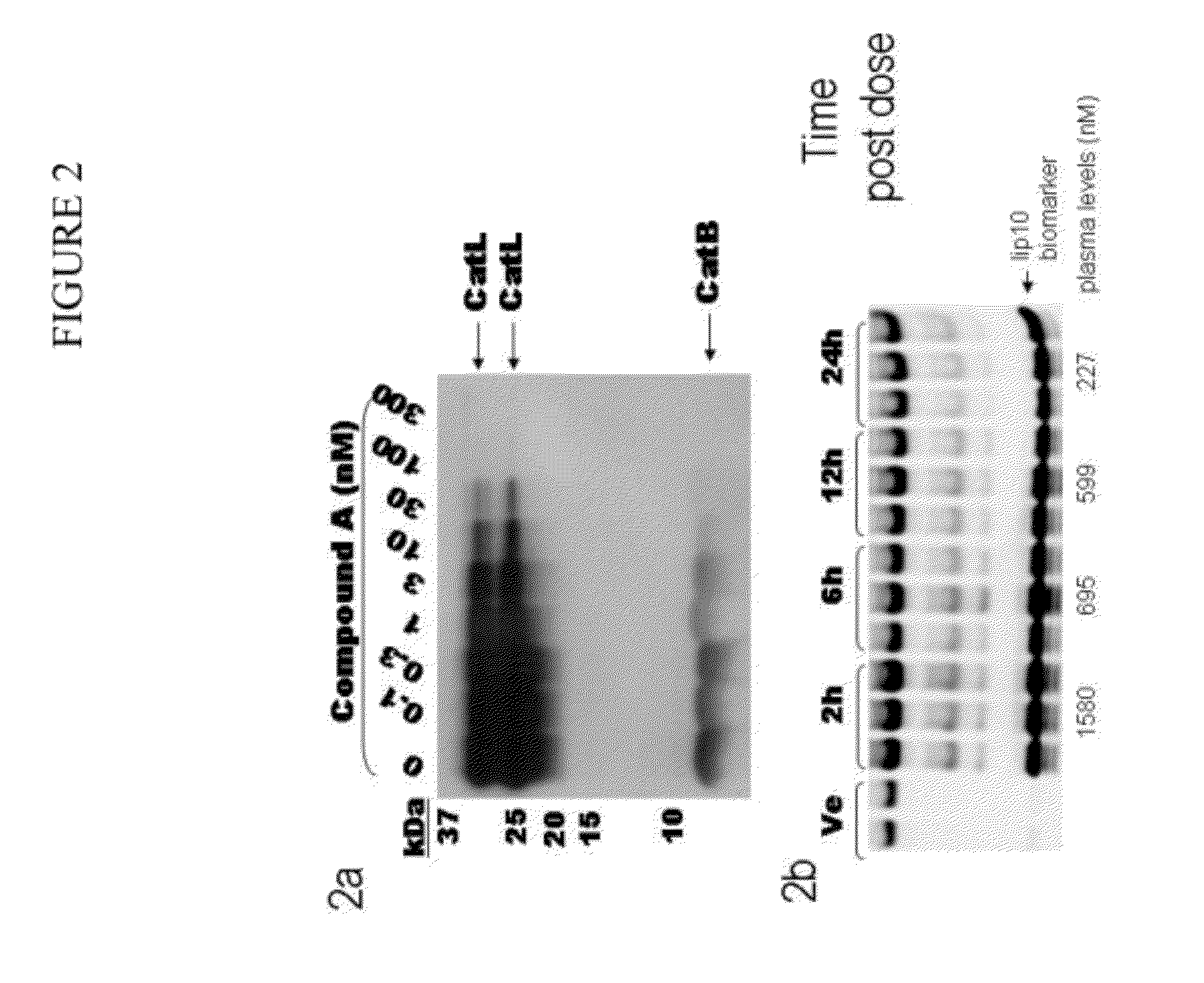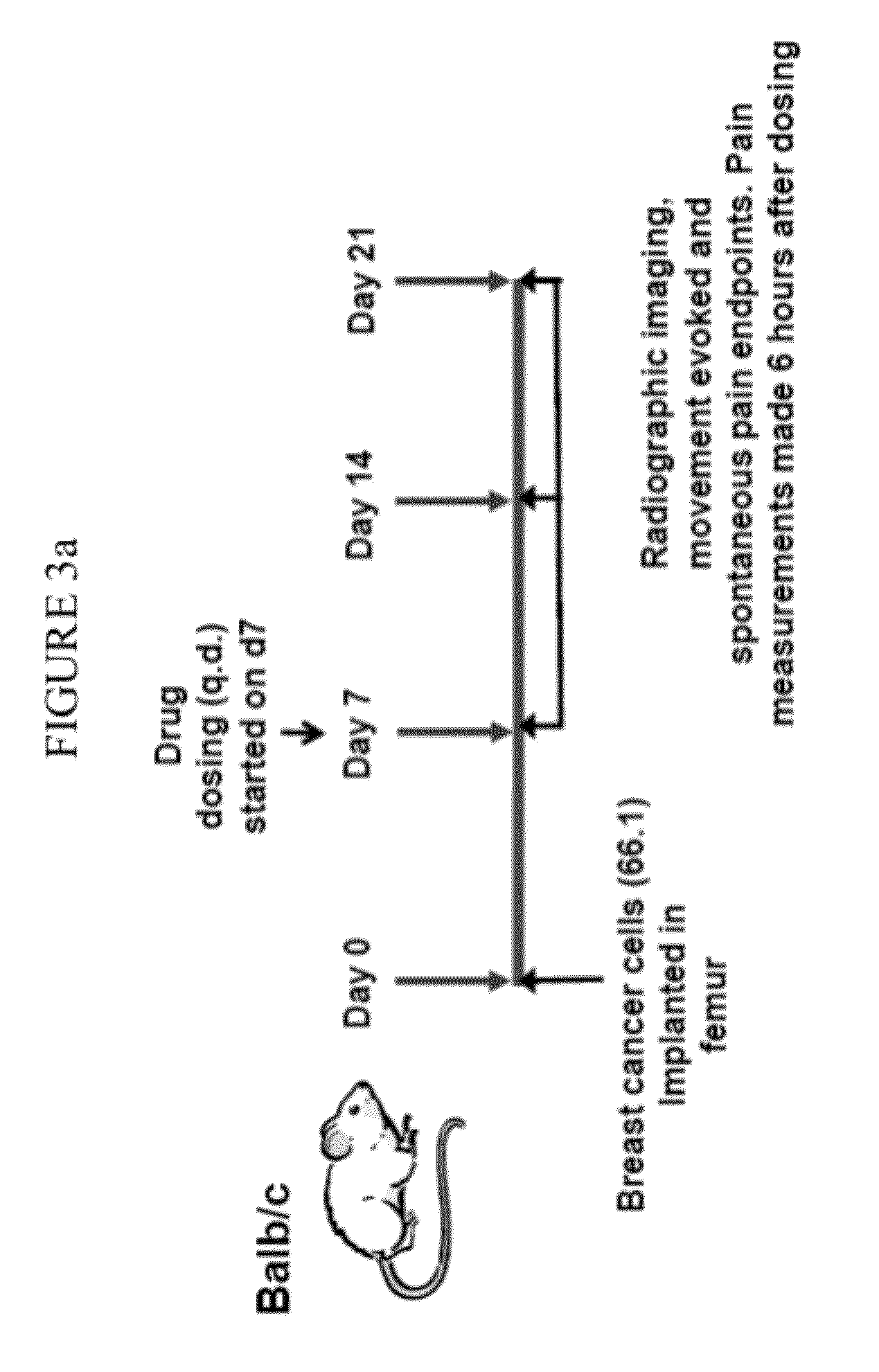Cathepsin inhibitors for the treatment of bone cancer and bone cancer pain
- Summary
- Abstract
- Description
- Claims
- Application Information
AI Technical Summary
Benefits of technology
Problems solved by technology
Method used
Image
Examples
example 7
Synthesis of (S)—N-Cyclopropyl-3-((R)-3-((3-(methylsulfonyl)phenyl)sulfonyl)-2-(((S)-2,2,2-trifluoro-1-(4-fluorophenyl)ethyl)amino)propanamido)-2-oxopentanamide (Compound B)
[0155]
Step 1
[0156]To a stirred solution of (2R)-2-((2,2,2-trifluoro-1-(4-fluorophenyl)ethyl)amino)-3-(tritylthio)propanoic acid (30.0 g; 55.6 mmol), previously obtained as a 12:1 mixture of the (R,S)- and (R,R)-diastereomers, in methanol (80 mL) and toluene (60 mL) under nitrogen was cooled in an ice-water bath. A 2M solution of trimethyldiazomethane in hexane (55 mL; 110 mmol; 198 mole %) over a 1-h period. The reaction mixture was stirred in the ice bath for an additional 15 minutes then at ambient temperature for 1 hour after which time the reaction was determined to be complete by thin-layer chromatographic analysis (SiO2; 4% methanol in dichloromethane). The reaction mixture was concentrated in vacuo to give a 37.3 g of a thick, dark brown oil. The residue was purified by chromatography (SiO2; dichloromethan...
example 1
[0165]Solutions of test compounds in varying concentrations were prepared in 101 μL of dimethyl sulfoxide (DMSO) and then diluted into assay buffer (40 μL, comprising: N,N-bis(2-hydroxyethyl)-2-aminoethanesulfonic acid (BES), 50 mM (pH 6); polyoxyethylenesorbitan monolaurate, 0.05%; and dithiothreitol (DTT), 2.5 mM). Human cathepsin B (0.025 pMoles in 25 μL of assay buffer) was added to the dilutions. The assay solutions were mixed for 5-10 seconds on a shaker plate, covered and incubated for 30 min at room temperature. Z-FR-AMC (20 nMoles in 25 μL of assay buffer) was added to the assay solutions and hydrolysis was followed spectrophotometrically at (λ 460 nm) for 5 min. Apparent inhibition constants (Ki) were calculated from the enzyme progress curves using standard mathematical models.
[0166]A number of compounds for use according to the invention were tested by the above-described assay and observed to exhibit cathepsin B inhibitory activity.
example 2
[0167]Solutions of test compounds in varying concentrations were prepared in 10 μL of dimethyl sulfoxide (DMSO) and then diluted into assay buffer (40 μL, comprising: MES, 50 mM (pH 5.5); EDTA, 2.5 mM; and DTT, 2.5 mM). Human cathepsin K (0.0906 pMoles in 25 μL of assay buffer) was added to the dilutions. The assay solutions were mixed for 5-10 seconds on a shaker plate, covered and incubated for 30 min at room temperature. Z-Phe-Arg-AMC (4 nMoles in 25 μL of assay buffer) was added to the assay solutions and hydrolysis was followed spectrophotometrically at (λ 460 nm) for 5 min. Apparent inhibition constants (Ki) were calculated from the enzyme progress curves using standard mathematical models.
[0168]A number of compounds for use according to the invention were tested by the above-described assay and observed to exhibit cathepsin K inhibitory activity.
PUM
| Property | Measurement | Unit |
|---|---|---|
| Pharmaceutically acceptable | aaaaa | aaaaa |
| Stress optical coefficient | aaaaa | aaaaa |
| Bioabsorbable | aaaaa | aaaaa |
Abstract
Description
Claims
Application Information
 Login to View More
Login to View More - R&D
- Intellectual Property
- Life Sciences
- Materials
- Tech Scout
- Unparalleled Data Quality
- Higher Quality Content
- 60% Fewer Hallucinations
Browse by: Latest US Patents, China's latest patents, Technical Efficacy Thesaurus, Application Domain, Technology Topic, Popular Technical Reports.
© 2025 PatSnap. All rights reserved.Legal|Privacy policy|Modern Slavery Act Transparency Statement|Sitemap|About US| Contact US: help@patsnap.com



